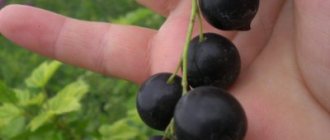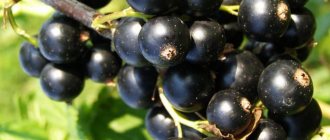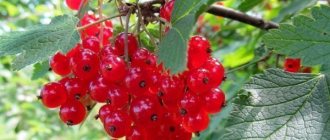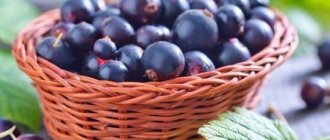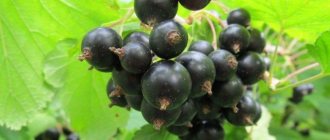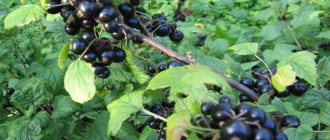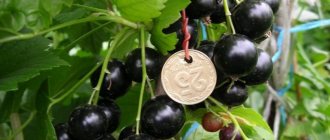Description of the blackcurrant variety Treasure
The bush of this variety is of medium density, slightly spreading, of medium height - rarely reaching more than 1.5 m in height. Smooth, slightly pubescent shoots of medium thickness are slightly geniculate. Young shoots are light green in color and end with an anthocyanin tip; woody branches acquire a light brown tint. Pointed, single, medium-sized light green buds with extending scales are ovoid in shape.
Three-lobed, slightly shiny leaves of a bright green color, leathery, wrinkled, asymmetrical, with teeth along the edge, sit on thick petioles at an angle of 45 degrees to the shoot. The medium-sized plate itself is distinguished by strongly depressed veins and has an open base of medium depth (in young leaves it may be closed). Each of the three blades is concave along its central vein, while the acute angle between the central veins of the lateral blades is clearly visible.
The Treasure variety blooms in small inflorescences with pink sepals and soft cream petals. Currant flowers are located on single and triple straight racemes of medium length and density (from 5 to 10 berries) with short, thick stalks.
Ripe berries are oval-shaped, black, moderately shiny, have a thin skin and a sweet and sour, extraordinary, very pleasant taste. The fruits are large (1.6 - 2.8 g) with dark red pulp and a large number of small seeds inside, and are distinguished by a small, closed cup. On a five-point scale, black currant berries of this variety have a tasting score of 4.4 points.
Since the Sokrovische variety was bred for cultivation in harsh conditions of frosty and long winters, it is recommended for cultivation in the West Siberian and East Siberian regions.
Below you can see a photo of black currant shoots of the Sokrovische variety with ripe berries.
Features of cultivation
Currant bush care photo
Treasure bushes should be planted in ventilated, illuminated areas; weak shadow is possible, the main thing is that it is not constant. The soil should be slightly acidic. Planting time: late September or early summer. Two-year-old seedlings are suitable for planting - they take root the fastest. A hole 50 cm deep is prepared 2 months before planting.
The land for planting is prepared separately. Add a bucket of humus (you can compost), 100 g of superphosphate and 50 g of potassium fertilizer to plain soil. The bush is planted according to the standard scheme - placed on a hill of soil, the roots are straightened, and covered with earth. If several bushes are planted, then leave about a meter of free space between them. After planting, the bush is watered with 2 buckets of water (20 l), and the root zone is mulched with sawdust.
Caring for the crop consists of several mandatory, regular procedures.
- Loosening of the root zone. To do this, use a small hoe or similar tool so as not to damage the roots.
- As weeds appear, they are pulled out by the roots and burned away from the site (so that the seeds do not scatter on the site), then over time there will be much less of them.
Photo of watering currants Treasure
- Water so that the soil under the bush does not dry out too much. Bushes especially need water in hot, dry weather.
- In spring, all branches with growth up to 20 cm and older than 3 years are cut off. It is also necessary to remove diseased, damaged pagons, from which there will be no benefit. At the end of summer, you can also trim off the immature tips of the shoots.
- Feeding is needed only from the 3rd year after the Treasure blackcurrant bush is planted. For the first two years, the fertilizer that was added to the planting soil will be sufficient. In the spring you need about 40 g of urea for each bush; in the fall, before winter, compost or humus (1/2 bucket), 20 g of potassium sulfate and 50 g of superphosphate are added. If the yield is low, you can also apply organic matter under the bushes up to 4 times during the season (chicken manure diluted with water in a ratio of 1:10).
- Treatment with fungicides or insecticides is carried out as necessary.
Characteristics of the variety
Black currant variety Sokrovische is an early-flowering, early-ripening, winter-hardy and high-yielding variety. The main feature of the variety is the short period of bush life and fruiting, amounting to seven years.
Important! To achieve a good yield of the Sokrovische variety, it is recommended to replace old currant bushes with new ones every five years.
Drought resistance, frost resistance
This variety of black currant is relatively drought-resistant and does not tolerate long-term lack of watering during the summer heat, when the weather is hot and dry.
The Sokrovische variety tolerates frosts well, down to -25 °C, but is suitable not only for the climatic conditions of Siberia. Currants are successfully grown in all regions of Russia.
Productivity of the variety
Black currants bloom in early May, and closer to the second half of June you can get the first fruits. The yield of the variety is very high and averages up to 4 - 5 kg of berries from one adult bush. The fruits ripen almost simultaneously, which is very convenient because it does not delay the harvesting process.
Ripe currant berries of the Sokrovische variety are well preserved on the branches and can remain on them in a ripe form, without losing their qualities, for up to 10 - 14 days. At the same time, they do not crumble or dry out in the sun, and their size does not decrease as they ripen. However, picked fruits can be stored fresh for no more than two days: after that they disappear. Since the berries have thin skin and do not keep well, they do not tolerate transportation over long distances.
The fruits of black currant Treasure can be consumed both raw and in the form of jam or jam. Frozen berries do not lose their nutritional properties and serve as an excellent filling for sweet pastries.
Resistance to diseases and pests
The Sokrovische variety is highly resistant to various diseases and garden pests due to its high immune resistance. With proper care, timely feeding, watering and pruning of diseased branches, the plant does not need additional attention.
Pros and cons of the variety
The main advantages of Treasure currants include:
- high productivity;
- frost resistance;
- one-dimensionality and taste of berries;
- high immunity;
- self-pollination;
- precociousness.
Disadvantages of the variety:
- short shelf life of berries;
- poor transportability;
- earlier aging of the bush.
In addition, do not forget that the variety does not tolerate prolonged drought, so it is important to organize regular watering in arid regions.
Harvesting and transportation, keeping quality of berries
The berries are collected gradually, in several stages. This is due to the fact that they do not mature together. When harvesting products, use small containers that can hold no more than 2 kg. Berries need to be transported in closed containers, into which 1.5 kg of fruit is placed. Due to the thin peel, the fruit may be damaged during transportation. The shelf life of fresh products in dry, cool and dark conditions is 3 months.
The shelf life of berries can be increased by placing them in the freezer. There they will be stored for up to 1 year. Growing Treasure currants is not difficult if you follow all the rules of agricultural technology and care. Its unpretentiousness makes this crop desirable both in the gardens of experienced gardeners and in the gardens of beginners.
Sources:
https://maja-dacha.ru/chyornaya-smorodina-sokrovishhe-krupnyie-i-vkusnyie/ https://fermerok.info/chernaya-smorodina-sokrovishhe https://fermer.blog/bok/sad/smorodina/sorta -smorodiny/srednie-sorta-smorodiny/10804-smorodina-sokrovische.html
Planting and care
The Treasure variety loves sunny, well-ventilated areas, but also grows well in light shade. For good health and abundant fruiting, the soil must be slightly acidic. The seedlings should be two years old - this way they tolerate transplantation better and will produce their first harvest within a year. A healthy plant should have a well-strong root system with roots 20 cm long.
The end of September is most suitable for transplanting young blackcurrant bushes from pots into free soil. In this case, the planting pit is prepared in advance, on average 50 - 60 days before the intended planting. The depth of the pit must be at least 0.5 meters.
A special soil mixture is also prepared in advance: a bucket of compost (humus), 0.1 kg of superphosphate and 0.05 kg of potash fertilizers are added to ordinary garden soil.
Landing algorithm:
- in the planting hole a mound is made from the prepared substrate;
- Holding the mound, place the seedling on the hill and carefully spread the roots along the slopes;
- the hole is filled up, and the planted currant bush is watered with 20 liters of water.
When planting several seedlings, you should maintain a distance between them of at least 1 m. After planting, be sure to mulch the soil with a layer of sawdust.
Aftercare
Immediately after planting, Treasure currant seedlings are pruned, leaving three buds. Next, pruning is carried out every spring; in the process, all dry and old branches and frozen tips of shoots are removed. After harvesting, branches lying on the ground and individual shoots that have reached more than 2.5 m in length are also removed.
Currants should be watered once or twice a week, with approximately 10 liters of water per bush. To retain moisture longer, the soil is mulched with sawdust, hay or manure and loosened regularly.
Starting from the third year of life, Treasure currants are fed twice during the entire season according to the following scheme:
- early spring - urea: 40 g per bush;
- in autumn - superphosphate and potassium sulfate: 20 and 50 g, respectively.
In addition, it is recommended to water the plant four times during the season with organic fertilizers: during the periods of bud break, flowering, fruit growth, and the last time - after picking the berries. Usually a solution of chicken manure is taken in a concentration of 1:10.
The branches of the Treasure currant bushes must be tied up or supported during the period of fruit ripening, since due to their abundance the shoots may break.
Due to the frost resistance of the variety, in warm regions the plant is usually not covered for the winter. In cold regions in the fall, all leaves are cut off from the shoots, dried and diseased shoots are removed, and the bush itself is wrapped in a special airtight coating or agrofibre.
To protect the root system of the shrub from damage by rodents, it is necessary to remove fallen leaves in the fall: mice later hide in them from the cold. Comprehensive protection is also carried out using chemicals, mechanical traps, small metal meshes or spruce branches.
Specifics of planting work
To obtain a high-quality harvest and maintain the productivity of the bush, you need to choose the right place and follow the planting technique.
See also
Causes and treatment of currant anthracnose, modern control measures
Read
Site selection and site preparation
Currants prefer places with good sunlight. It should last at least 12 hours a day in the summer. The culture loves well-ventilated areas, but without north winds.
Important!
Cold gusty wind will lead to the death of the bush. It is preferable to use soil with a slightly acidic environment. If the acidity is higher, then the soil is limed. The site is prepared in advance, no later than 2 weeks before planting. To do this, certain actions are carried out:
- All large stones and weeds are removed from the garden bed.
- Dig a hole 50 cm deep and 30 cm in diameter.
- The excavated soil is mixed with humus and a mineral complex containing nitrogen, phosphorus, and potassium.
- Half of the mixture is placed back into the pit.
- Leave for 2 weeks or until spring.
Planting dates and technology
For temperate and northern climates, planting is recommended in early spring. At a time when the snow has completely melted and the top layer of soil has thawed. Autumn planting is also possible, but the survival rate of the seedling is reduced.
Important! If the seedling was purchased in the fall, then it is stored in a greenhouse with the roots lightly buried until spring in a horizontal position.
The procedure for planting shrubs is the same as for other crops. Follow the following algorithm:
- The young plant is soaked in a solution of potassium permanganate for a day.
- The plant is placed in a hole.
- Straighten all the roots with your hands.
- Seal the hole layer by layer.
- Each layer is compacted tightly.
- The penultimate layer is peat.
- Water the currants with 10 liters of water.
Pest and disease control
Despite its resistance to diseases and pests, the Treasure currant still has its enemies.
The most common diseases:
- powdery mildew;
- rust;
- anthracnose;
- septoria (white spotting).
To minimize the possibility of infection of the crop with infectious and fungal diseases, it is recommended to spray the bushes in the spring for preventive purposes. As soon as the melted snow melts, the currants should be sprayed with copper sulfate (100 g per bucket of water) or simply with very warm water (60 °C).
In addition, the following insects cause harm to the plant:
- bud moth;
- spider mite;
- glassware;
- aphid;
- currant sawfly.
To combat pests, it is necessary to regularly weed out weeds near currant bushes and loosen the soil.
Agricultural technology
The technology for planting the black currant variety Treasure is not complicated. First you need to prepare a place for planting.
After this, you need to buy seedlings, when choosing which some features should be taken into account:
- age - from 1 to 2 years;
- root length - 40–50 cm;
- plant height - 70 cm;
- absence of rot, white plaque and cracks.
After purchase, you need to prepare planting material. First, the roots are soaked in a manganese solution (20 g per 5 liters of water) for 5 hours to disinfect. After this, you need to place them in “Kornevin” for 5 days (100 g per 10 liters of water). This will speed up the growth of the plant.
